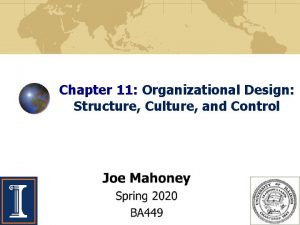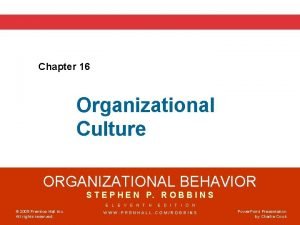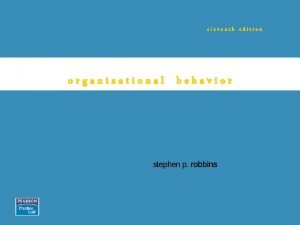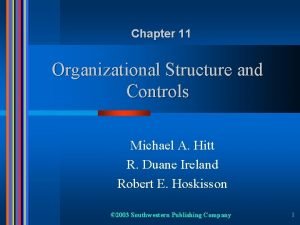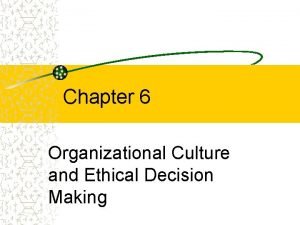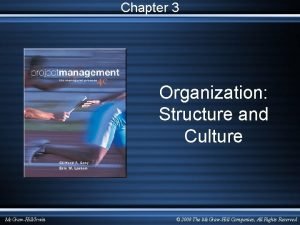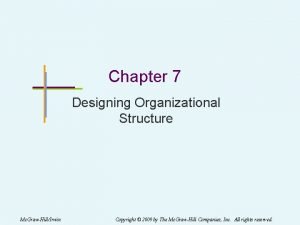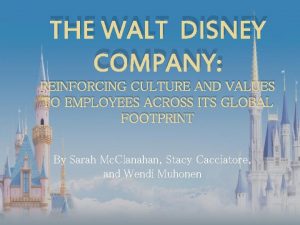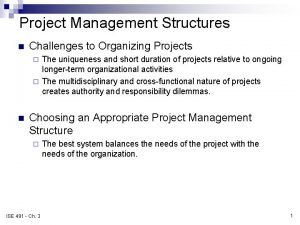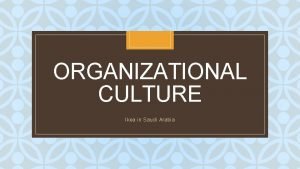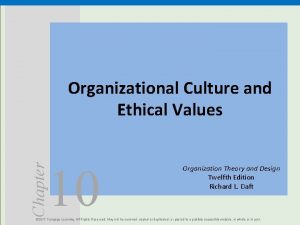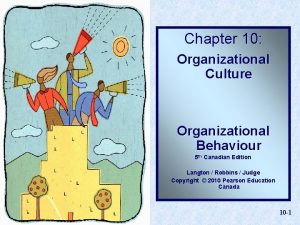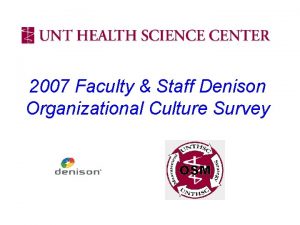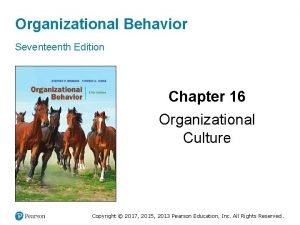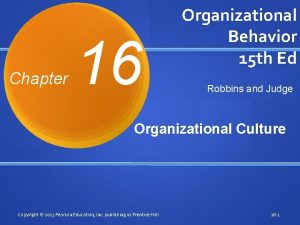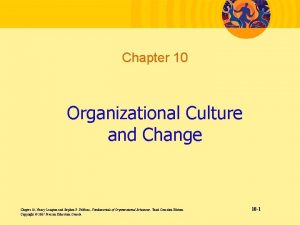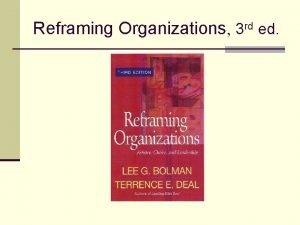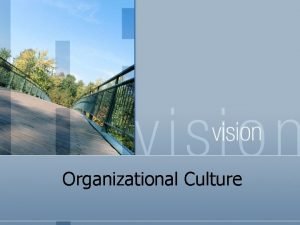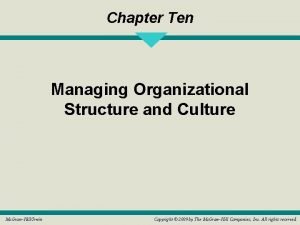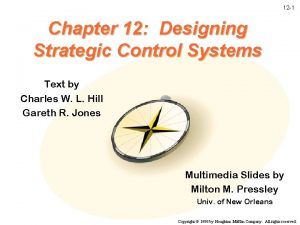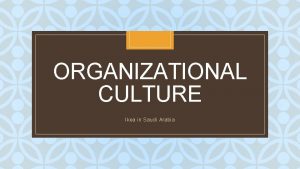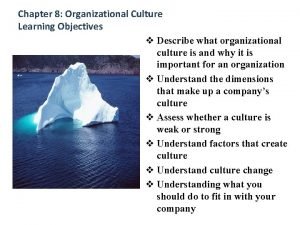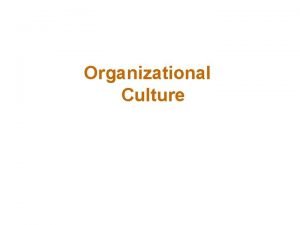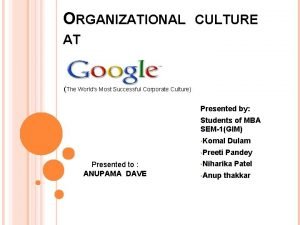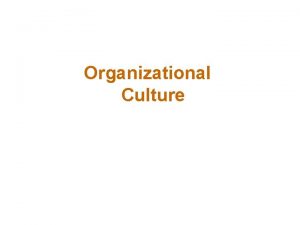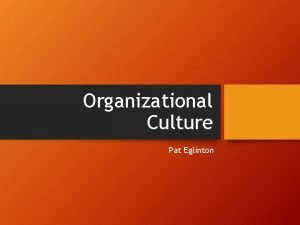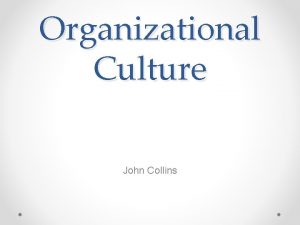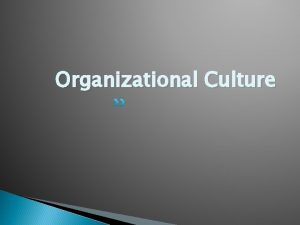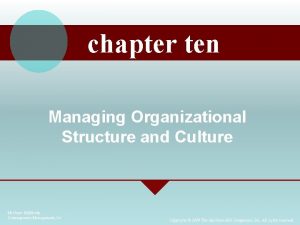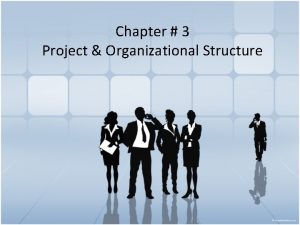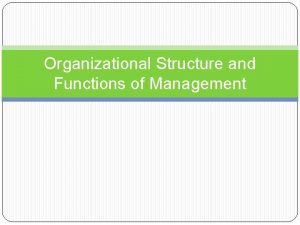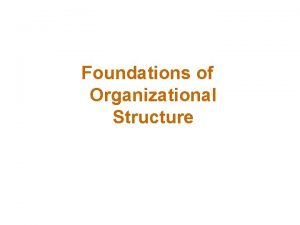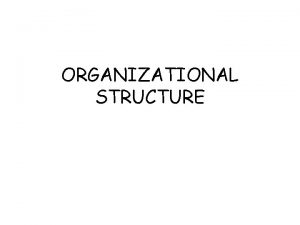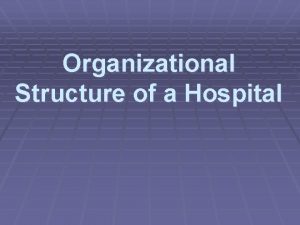Chapter 10 Managing Organizational Structure and Culture 2016








































- Slides: 40

Chapter 10 Managing Organizational Structure and Culture © 2016 by Mc. Graw-Hill Education. This is proprietary material solely for authorized instructor use. Not authorized for sale or distribution in any manner. This document may not be copied, scanned, duplicated, forwarded, distributed, or posted on a website, in whole or part.

Learning Objectives 1. Identify the factors that influence managers’ choice of an organizational structure. 2. Explain how managers group tasks into jobs that are motivating and satisfying for employees. 3. Describe the types of organizational structures managers can design, and explain why they choose one structure over another. 4. Explain why managers must coordinate jobs, functions, and divisions using the hierarchy of authority and integrating mechanisms 5. List the four sources of organizational culture, and explain why and how a company’s culture can lead to competitive advantage. © 2016 by Mc. Graw-Hill Education. This is proprietary material solely for authorized instructor use. Not authorized for sale or distribution in any manner. This document may not be copied, scanned, duplicated, forwarded, distributed, or posted on a website, in whole or part. 10 -2

Organizational Structure Organizational Architecture The organizational structure, control systems, culture, and human resource management systems that together determine how efficiently and effectively organizational resources are used. © 2016 by Mc. Graw-Hill Education. This is proprietary material solely for authorized instructor use. Not authorized for sale or distribution in any manner. This document may not be copied, scanned, duplicated, forwarded, distributed, or posted on a website, in whole or part. 10 -3

Designing Organizational Structure Organizing The process by which managers establish working relationships among employees to achieve goals. © 2016 by Mc. Graw-Hill Education. This is proprietary material solely for authorized instructor use. Not authorized for sale or distribution in any manner. This document may not be copied, scanned, duplicated, forwarded, distributed, or posted on a website, in whole or part. 10 -4

Designing Organizational Structure formal system of task and reporting relationships that coordinates and motivates organizational members so they work together to achieve organizational goals. © 2016 by Mc. Graw-Hill Education. This is proprietary material solely for authorized instructor use. Not authorized for sale or distribution in any manner. This document may not be copied, scanned, duplicated, forwarded, distributed, or posted on a website, in whole or part. 10 -5

Factors Affecting Organizational Structure © 2016 by Mc. Graw-Hill Education. This is proprietary material solely for authorized instructor use. Not authorized for sale or distribution in any manner. This document may not be copied, scanned, duplicated, forwarded, distributed, or posted on a website, in whole or part. 10 -6

Designing Organizational Structure Organizational design The process by which managers create a specific type of organizational structure and culture so that a company can operate in the most efficient and effective way © 2016 by Mc. Graw-Hill Education. This is proprietary material solely for authorized instructor use. Not authorized for sale or distribution in any manner. This document may not be copied, scanned, duplicated, forwarded, distributed, or posted on a website, in whole or part. 10 -7

Designing Organizational Structure The way an organization’s structure works depends on the choices managers make about: 1. How to group tasks into individual jobs 2. How to group jobs into functions and divisions 3. How to allocate authority and coordinate functions and divisions © 2016 by Mc. Graw-Hill Education. This is proprietary material solely for authorized instructor use. Not authorized for sale or distribution in any manner. This document may not be copied, scanned, duplicated, forwarded, distributed, or posted on a website, in whole or part. 10 -8

Grouping Tasks into Jobs: Job Design The process by which managers decide how to divide tasks into specific jobs. The appropriate division of labor results in an effective and efficient workforce. © 2016 by Mc. Graw-Hill Education. This is proprietary material solely for authorized instructor use. Not authorized for sale or distribution in any manner. This document may not be copied, scanned, duplicated, forwarded, distributed, or posted on a website, in whole or part. 10 -9

Job Design Job Simplification The process of reducing the number of tasks that each worker performs. Job Enlargement Increasing the number of different tasks in a given job by changing the division of labor Job Enrichment Increasing the degree of responsibility a worker has over a job © 2016 by Mc. Graw-Hill Education. This is proprietary material solely for authorized instructor use. Not authorized for sale or distribution in any manner. This document may not be copied, scanned, duplicated, forwarded, distributed, or posted on a website, in whole or part. 10 -10

Job Enrichment 1. Empowering workers to experiment to find new or better ways of doing the job 2. Encouraging workers to develop new skills 3. Allowing workers to decide how to do the work 4. Allowing workers to monitor and measure their own performance © 2016 by Mc. Graw-Hill Education. This is proprietary material solely for authorized instructor use. Not authorized for sale or distribution in any manner. This document may not be copied, scanned, duplicated, forwarded, distributed, or posted on a website, in whole or part. 10 -11

The Job Characteristics Model © 2016 by Mc. Graw-Hill Education. This is proprietary material solely for authorized instructor use. Not authorized for sale or distribution in any manner. This document may not be copied, scanned, duplicated, forwarded, distributed, or posted on a website, in whole or part. 10 -12

Grouping Jobs into Functions Functional Structure An organizational structure composed of all the departments that an organization requires to produce its goods or services. © 2016 by Mc. Graw-Hill Education. This is proprietary material solely for authorized instructor use. Not authorized for sale or distribution in any manner. This document may not be copied, scanned, duplicated, forwarded, distributed, or posted on a website, in whole or part. 10 -13

Functional Structure Advantages Encourages learning from others doing similar jobs. Easy for managers to monitor and evaluate workers. Allows managers to create the set of functions they need in order to scan and monitor the competitive environment © 2016 by Mc. Graw-Hill Education. This is proprietary material solely for authorized instructor use. Not authorized for sale or distribution in any manner. This document may not be copied, scanned, duplicated, forwarded, distributed, or posted on a website, in whole or part. 10 -14

Example – A. C. Moore Arts & Crafts A. C. Moore is organized with a functional structure Examples of divisions are Marketing & Merchandising, Stores & Loss Prevention, Store Operations, Merchandise Administration, Real Estate, and Legal © 2016 by Mc. Graw-Hill Education. This is proprietary material solely for authorized instructor use. Not authorized for sale or distribution in any manner. This document may not be copied, scanned, duplicated, forwarded, distributed, or posted on a website, in whole or part. 10 -15

Functional Structure Disadvantages Difficult for departments to communicate with others. Preoccupation with own department and losing sight of organizational goals. © 2016 by Mc. Graw-Hill Education. This is proprietary material solely for authorized instructor use. Not authorized for sale or distribution in any manner. This document may not be copied, scanned, duplicated, forwarded, distributed, or posted on a website, in whole or part. 10 -16

Divisional Structures Divisional Structure An organizational structure composed of separate business units within which are the functions that work together to produce a specific product for a specific customer. Product, market, geographic © 2016 by Mc. Graw-Hill Education. This is proprietary material solely for authorized instructor use. Not authorized for sale or distribution in any manner. This document may not be copied, scanned, duplicated, forwarded, distributed, or posted on a website, in whole or part. 10 -17

Product, Market, and Geographic Structures © 2016 by Mc. Graw-Hill Education. This is proprietary material solely for authorized instructor use. Not authorized for sale or distribution in any manner. This document may not be copied, scanned, duplicated, forwarded, distributed, or posted on a website, in whole or part. 10 -18

Types of Divisional Structures Product Structure Managers place each distinct product line or business in its own self-contained division Divisional managers have the responsibility for devising an appropriate business-level strategy to allow the division to compete effectively in its industry or market © 2016 by Mc. Graw-Hill Education. This is proprietary material solely for authorized instructor use. Not authorized for sale or distribution in any manner. This document may not be copied, scanned, duplicated, forwarded, distributed, or posted on a website, in whole or part. 10 -19

Product Structure Allows functional managers to specialize in one product area Division managers become experts in their area Removes need for direct supervision of division by corporate managers Divisional management improves the use of resources © 2016 by Mc. Graw-Hill Education. This is proprietary material solely for authorized instructor use. Not authorized for sale or distribution in any manner. This document may not be copied, scanned, duplicated, forwarded, distributed, or posted on a website, in whole or part. 10 -20

Types of Divisional Structures Geographic Structure Divisions are broken down by geographic location Global geographic structure Managers locate different divisions in each of the world regions where the organization operates. Generally, occurs when managers are pursuing a multi-domestic strategy © 2016 by Mc. Graw-Hill Education. This is proprietary material solely for authorized instructor use. Not authorized for sale or distribution in any manner. This document may not be copied, scanned, duplicated, forwarded, distributed, or posted on a website, in whole or part. 10 -21

Types of Divisional Structures Market Structure Groups divisions according to the particular kinds of customers they serve Allows managers to be responsive to the needs of their customers and act flexibly in making decisions in response to customers’ changing needs © 2016 by Mc. Graw-Hill Education. This is proprietary material solely for authorized instructor use. Not authorized for sale or distribution in any manner. This document may not be copied, scanned, duplicated, forwarded, distributed, or posted on a website, in whole or part. 10 -22

Matrix Design Structure Matrix Structure An organizational structure that simultaneously groups people and resources by function and product. The structure is very flexible and can respond rapidly to the need for change. Each employee has two bosses © 2016 by Mc. Graw-Hill Education. This is proprietary material solely for authorized instructor use. Not authorized for sale or distribution in any manner. This document may not be copied, scanned, duplicated, forwarded, distributed, or posted on a website, in whole or part. 10 -23

Matrix Structure © 2016 by Mc. Graw-Hill Education. This is proprietary material solely for authorized instructor use. Not authorized for sale or distribution in any manner. This document may not be copied, scanned, duplicated, forwarded, distributed, or posted on a website, in whole or part. 10 -24

Product Team Design Structure Product Team Structure in which employees are permanently assigned to a cross-functional team and report only to the product team manager or to one of his direct subordinates Does away with dual reporting relationships and two-boss managers © 2016 by Mc. Graw-Hill Education. This is proprietary material solely for authorized instructor use. Not authorized for sale or distribution in any manner. This document may not be copied, scanned, duplicated, forwarded, distributed, or posted on a website, in whole or part. 10 -25

Product Team Structure Cross-functional team A group of managers brought together from different departments to perform organizational tasks. © 2016 by Mc. Graw-Hill Education. This is proprietary material solely for authorized instructor use. Not authorized for sale or distribution in any manner. This document may not be copied, scanned, duplicated, forwarded, distributed, or posted on a website, in whole or part. 10 -26

Product Team Structure © 2016 by Mc. Graw-Hill Education. This is proprietary material solely for authorized instructor use. Not authorized for sale or distribution in any manner. This document may not be copied, scanned, duplicated, forwarded, distributed, or posted on a website, in whole or part. 10 -27

Allocating Authority power to hold people accountable for their actions and to make decisions concerning the use of organizational resources. Hierarchy of authority An organization’s chain of command, specifying the relative authority of each manager. © 2016 by Mc. Graw-Hill Education. This is proprietary material solely for authorized instructor use. Not authorized for sale or distribution in any manner. This document may not be copied, scanned, duplicated, forwarded, distributed, or posted on a website, in whole or part. 10 -28

Allocating Authority Line Manager Someone in the direct line or chain of command who has formal authority over people and resources at lower levels Staff Manager Someone responsible for managing a specialist function, such as finance or marketing. © 2016 by Mc. Graw-Hill Education. This is proprietary material solely for authorized instructor use. Not authorized for sale or distribution in any manner. This document may not be copied, scanned, duplicated, forwarded, distributed, or posted on a website, in whole or part. 10 -29

Tall and Flat Organizations Tall structures have many levels of authority and narrow spans of control. As hierarchy levels increase, communication gets difficult creating delays in the time being taken to implement decisions. Communications can also become distorted as it is repeated through the firm. Can become expensive © 2016 by Mc. Graw-Hill Education. This is proprietary material solely for authorized instructor use. Not authorized for sale or distribution in any manner. This document may not be copied, scanned, duplicated, forwarded, distributed, or posted on a website, in whole or part. 10 -30

Tall Organizations © 2016 by Mc. Graw-Hill Education. This is proprietary material solely for authorized instructor use. Not authorized for sale or distribution in any manner. This document may not be copied, scanned, duplicated, forwarded, distributed, or posted on a website, in whole or part. 10 -31

Tall and Flat Organizations Flat structures have fewer levels and wide spans of control. Structure results in quick communications but can lead to overworked managers. © 2016 by Mc. Graw-Hill Education. This is proprietary material solely for authorized instructor use. Not authorized for sale or distribution in any manner. This document may not be copied, scanned, duplicated, forwarded, distributed, or posted on a website, in whole or part. 10 -32

Centralization and Decentralization of Authority Decentralizing authority giving lower-level managers and non-managerial employees the right to make important decisions about how to use organizational resources © 2016 by Mc. Graw-Hill Education. This is proprietary material solely for authorized instructor use. Not authorized for sale or distribution in any manner. This document may not be copied, scanned, duplicated, forwarded, distributed, or posted on a website, in whole or part. 10 -33

Integrating Mechanisms © 2016 by Mc. Graw-Hill Education. This is proprietary material solely for authorized instructor use. Not authorized for sale or distribution in any manner. This document may not be copied, scanned, duplicated, forwarded, distributed, or posted on a website, in whole or part. 10 -34

Sources of an Organization’s Culture © 2016 by Mc. Graw-Hill Education. This is proprietary material solely for authorized instructor use. Not authorized for sale or distribution in any manner. This document may not be copied, scanned, duplicated, forwarded, distributed, or posted on a website, in whole or part. 10 -35

Organizational Culture Organizational culture The shared set of beliefs, expectations, values, and norms that influence how members of an organization relate to one another and cooperate to achieve organizational goals. © 2016 by Mc. Graw-Hill Education. This is proprietary material solely for authorized instructor use. Not authorized for sale or distribution in any manner. This document may not be copied, scanned, duplicated, forwarded, distributed, or posted on a website, in whole or part. 10 -36

Organizational Culture Organizational ethics The moral values, beliefs, and rules that establish the appropriate way for an organization and its members to deal with each other and with people outside the organization. © 2016 by Mc. Graw-Hill Education. This is proprietary material solely for authorized instructor use. Not authorized for sale or distribution in any manner. This document may not be copied, scanned, duplicated, forwarded, distributed, or posted on a website, in whole or part. 10 -37

Employment Relationship Human resource policies: Can influence how hard employees will work to achieve the organization’s goals, How attached they will be to it Whether or not they will buy into its values and norms © 2016 by Mc. Graw-Hill Education. This is proprietary material solely for authorized instructor use. Not authorized for sale or distribution in any manner. This document may not be copied, scanned, duplicated, forwarded, distributed, or posted on a website, in whole or part. 10 -38

Strong, Adaptive Cultures Versus Weak, Inert Cultures Adaptive cultures values and norms help an organization to build momentum and to grow and change as needed to achieve its goals and be effective Inert cultures Those that lead to values and norms that fail to motivate or inspire employees Lead to stagnation and often failure over time © 2016 by Mc. Graw-Hill Education. This is proprietary material solely for authorized instructor use. Not authorized for sale or distribution in any manner. This document may not be copied, scanned, duplicated, forwarded, distributed, or posted on a website, in whole or part. 10 -39

Video: Container Store The Container Store provides significantly more training for its employees than the industry norm. How does this training impact job enrichment at The Container Store? Employees at The Container Store have a 5 -minute "huddle" every morning. What is the purpose of this meeting, and how does it reinforce the culture of the organization? © 2016 by Mc. Graw-Hill Education. This is proprietary material solely for authorized instructor use. Not authorized for sale or distribution in any manner. This document may not be copied, scanned, duplicated, forwarded, distributed, or posted on a website, in whole or part. 10 -40
 Organizational design: structure, culture, and control
Organizational design: structure, culture, and control Customer responsive culture
Customer responsive culture Creating a customer responsive culture
Creating a customer responsive culture Sbu m-form structure
Sbu m-form structure Organizational culture and ethical decision making
Organizational culture and ethical decision making Organizational culture diagnosis worksheet
Organizational culture diagnosis worksheet Forms of pop culture
Forms of pop culture Batch culture vs continuous culture
Batch culture vs continuous culture Difference between american culture and indian culture
Difference between american culture and indian culture Stab and stroke culture
Stab and stroke culture Folk culture and popular culture venn diagram
Folk culture and popular culture venn diagram Chapter 4 folk and popular culture
Chapter 4 folk and popular culture Stab culture and stroke culture
Stab culture and stroke culture Homework due today
Homework due today Carpet culture method
Carpet culture method Describe lawn culture and surface plating
Describe lawn culture and surface plating Surface culture deep culture and esol
Surface culture deep culture and esol Chapter 7 designing organizational structure
Chapter 7 designing organizational structure Chapter 7 designing organizational structure
Chapter 7 designing organizational structure The walt disney company culture
The walt disney company culture Organizational culture diagnosis worksheet
Organizational culture diagnosis worksheet Ikea symbols meaning
Ikea symbols meaning In an inert organizational culture,
In an inert organizational culture, Aspects of organizational culture
Aspects of organizational culture 3 levels of organizational culture
3 levels of organizational culture The denison organizational culture survey
The denison organizational culture survey Organizational culture definition by authors
Organizational culture definition by authors Organizational behavior
Organizational behavior (lo7) culture is
(lo7) culture is Characteristics of organizational culture
Characteristics of organizational culture Reframing organizational culture
Reframing organizational culture Organizational culture inventory
Organizational culture inventory Inert organizational culture
Inert organizational culture Inert organizational culture
Inert organizational culture Ikea corporate culture
Ikea corporate culture Organizational culture is related to the polc function of
Organizational culture is related to the polc function of Institutionalization organizational culture
Institutionalization organizational culture Google organizational culture
Google organizational culture Individual culture traits combine to form culture patterns.
Individual culture traits combine to form culture patterns. Batch culture vs continuous culture
Batch culture vs continuous culture Collectivistic cultures
Collectivistic cultures
